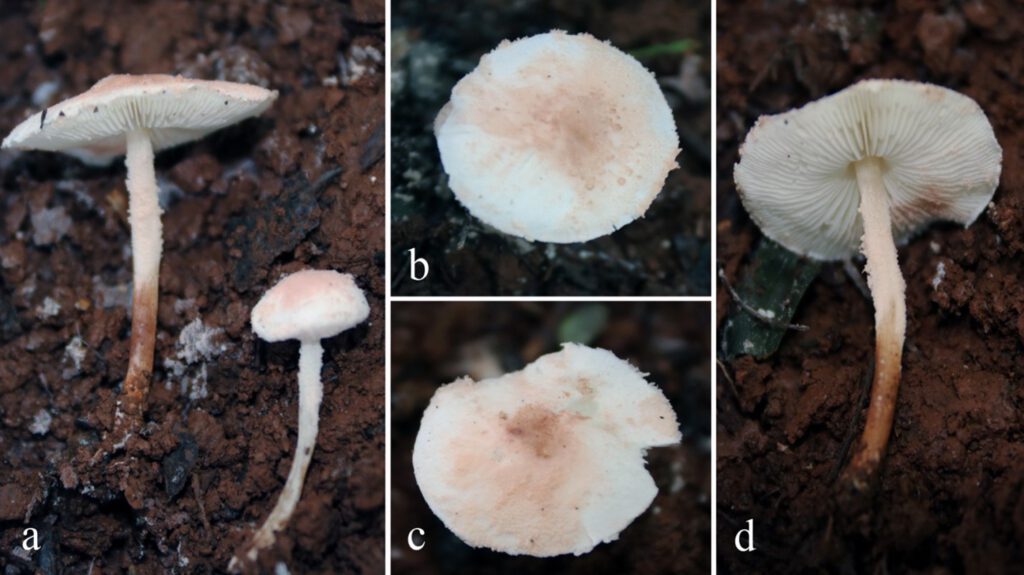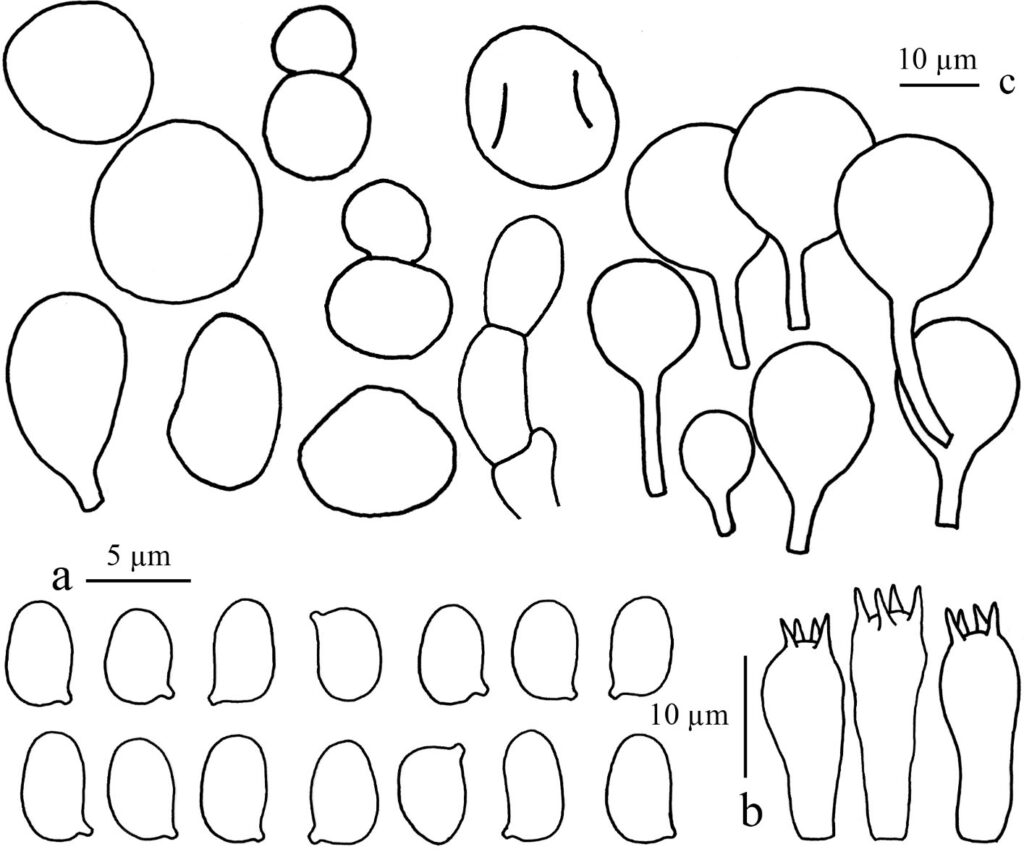Cystolepiota thailandica
MycoBank number: MB; Index Fungorum number: IF; Facesoffungi number: FoF 10597;
Description
Pileus 25–32 mm diam., first hemispherical to convex, expanding to convex or slightly plano-concave, with inflexed margin, when young granulose to powdery, greyish orange (6B3–5), soon breaking up, granulose to powdery at center toward margin, sometimes fragile when mature, on white powdery background; margin covered with granulose to powdery velar remnants, concolorous to those on surface. Lamellae free, 1.5–2 mm wide, crowded, white, broadly ventricose, with 3–4 lamellulae, with concolorous eroded edge, turning light brown to brown (7D5-8) when touched. Stipe 25–35 × 1.5–2.5 mm, cylindrical, completely covered with white to greyish orange (6B3–5) granulose to powdery velar remnants, on white background, turning light brown to brown (7D5-8) when touched. Annulus an annular zone with white to greyish orange (6B3–5) remnants. Context white in pileus, 1–1.5 mm thick at center; hollow in stipe and concolorous with surface. Odor and taste not observed. Spore pint white.
Basidiospores [50,2,2] 4.0–5.0 × 1.8–2.5 µm, avl × avw =4.30 × 2.24 µm , Q = 1.7–2.0, avQ = 1.91, ellipsoid-ovoid in frontal view, ellipsoid in side-view, slightly thick-walled, smooth, hyaline, non-dextrinoid, non-amyloid. Basidia 15–20 × 5.0–7.0 µm, short clavate to clavate, thin-walled, hyaline, 4-spored. Pleurocystidia absent. Cheilocystidia absent. Pileus covering an epithelium composed of globose to subglobose and sphero-pedunculate element cells, 10–35 µm wide, hyaline to pale brown parietal pigments. Stipe covering an epithelium same to that on pileus. Clamp-connections present in all tissues.
Habitat and distribution – growing solitary or in a small group with few basidiomata, saprotrophic on humus-rich soil with dead leaves. Found under cultivated trees of Ficus annulata Blume.
Additional materials examined – Thailand, Chiang Rai Province, Muang District, Mae Fah Luang University Campus, 11 January 2019, Yuan S. Liu (STO-2019-062, holotype); ibediem, 11 January 2019, Yuan S. Liu (STO-2019-063, paratype).
GenBank numbers: ITS: MZ574554, MZ574555 (ITS1-F/ITS4).
Notes – Cystolepiota thailandica is not related to any species in the genus by morphology. Cystolepiota seminuda (Lasch) Bon is similar to C. thailandica by having globose and sphero-pedunculate element cells on pileus- and stipe covering and absence of cheilo- and pleurocystidia; but is different on having white to pale pink or yellowish pileus and stipe covering, yellowish-creamy lamellae with pale lemon-yellow tinge, not discolouring with when damaged, slightly larger basidiospores (3.5–5.5 x 2.0–3.0 µm) (Vellinga, 1987). Cystolepiota bucknallii (Berk. & Broome) Singer & Clémençon is different by having lilac or violaceous powdery covering on pileus and stipe, pale yellow to pastel yellow lamellae and lacking of spheropedunculate element cells (Vellinga, 2007; Vellinga & Huijser, 1998). Cystolepiota pseudogranulosa (Berk. & Broome) Pegler, described from Sri Lanka, differs in the strongly dextrinoid spores, and the irregularly shaped pileus covering elements (Pegler1986).
The phylogenetic tree showed that C. thailandica is separated from other species for which sequence data are available (Fig. 1).
Habitat and distribution – growing in small groups, saprotrophic on humus-rich soil of mixed deciduous forest with Castanopsis spp. and Lithocarpus spp. dominant; the species is rare; and so far, known from Oudomxay province, northern Laos, and Chiang Rai province, northern Thailand.
Additional material examined – Thailand, Chiang Rai Province, Muang District, Phoo Kham Fah village, 15 Aug. 2012, P. Sysouphanthong, PS2012-11 (MFLU12-1774, paratype).
GenBank numbers: ITS: MZ574556 (ITS1-F/ITS4).
Notes – Cystolepiota thailandica is not related to any species in the genus by morphology. Cystolepiota seminuda (Lasch) Bon is similar to C. thailandica by having globose and sphero-pedunculate element cells on pileus- and stipe covering and absence of cheilo- and pleurocystidia; but is different on having white to pale pink or yellowish pileus and stipe covering, yellowish-creamy lamellae with pale lemon-yellow tinge, not discolouring with when damaged, slightly larger basidiospores (3.5–5.5 x 2.0–3.0 µm) (Vellinga, 1987). Cystolepiota bucknallii (Berk. & Broome) Singer & Clémençon is different by having lilac or violaceous powdery covering on pileus and stipe, pale yellow to pastel yellow lamellae and lacking of spheropedunculate element cells (Vellinga, 2007; Vellinga & Huijser, 1998). Cystolepiota pseudogranulosa (Berk. & Broome) Pegler, described from Sri Lanka, differs in the strongly dextrinoid spores, and the irregularly shaped pileus covering elements (Pegler1986).

Fig. 1 – Macrocharacters of Cystolepiota thailandica. a-b= STO-2019-062 (holotype), c-d= STO-2019-063 (paratype).

Fig. 2 – Microcharacters of Cystolepiota thailandica (STO-2019-062, holotype). a= basidiospores, b= basidia, c= pileus covering cells.
